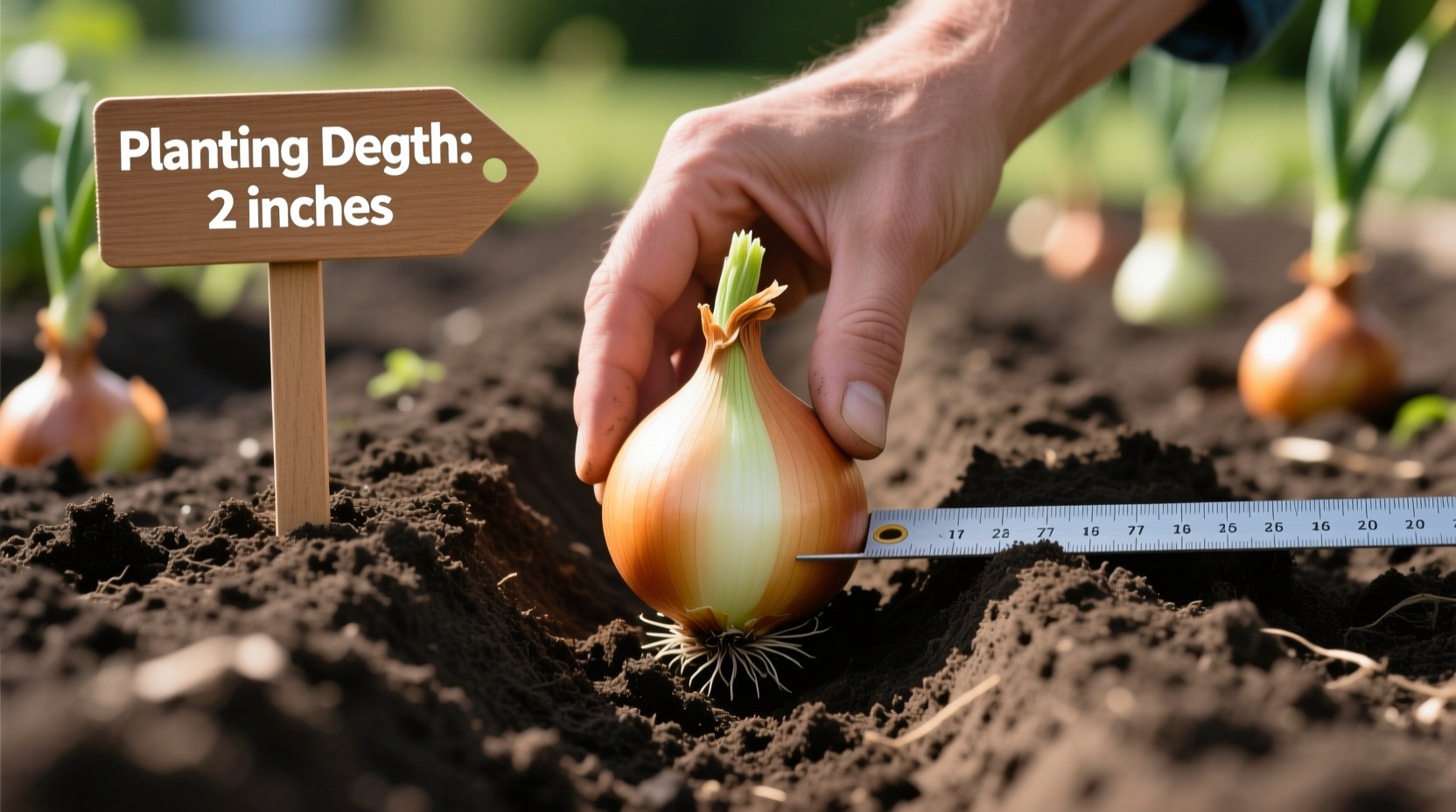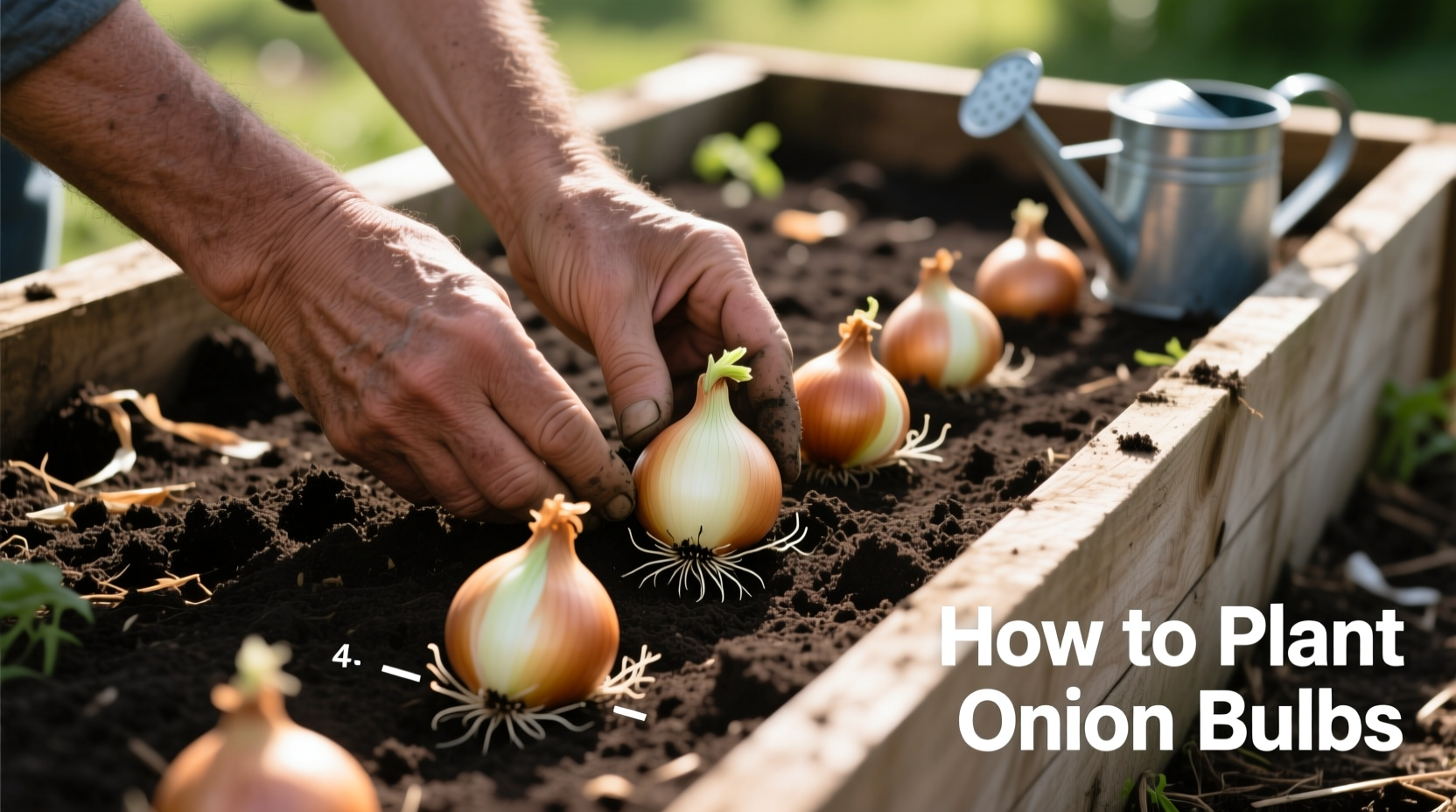Discover exactly how to plant onion bulbs for a bountiful harvest with this comprehensive, science-backed guide. Whether you're a first-time gardener or looking to perfect your technique, you'll learn optimal planting depth, timing by USDA zone, soil preparation methods, and troubleshooting tips that most guides miss. By following these evidence-based practices, you'll grow larger, sweeter onions with fewer pests and diseases.
When to Plant Onion Bulbs: Timing by Climate Zone
Timing is critical for successful onion growth. Planting too early exposes bulbs to harsh conditions, while late planting reduces bulb size. The USDA Planting Zone Timeline provides clear guidance:
| USDA Hardiness Zone | Optimal Planting Window | Soil Temperature Minimum |
|---|---|---|
| Zones 3-5 | Early to mid-April | 40°F (4°C) |
| Zones 6-7 | Late March to early April | 40°F (4°C) |
| Zones 8-10 | October to November (fall planting) | 50°F (10°C) |
According to the University of Minnesota Extension, "onions require 90-120 days of cool weather to develop properly before summer heat triggers bulb formation." Planting within these windows ensures your onions receive adequate cool-season growth before bulb development begins.
Selecting the Right Onion Bulbs for Your Region
Not all onion varieties perform equally in every climate. Understanding day-length requirements prevents wasted effort:
- Short-day onions (10-12 hours of daylight): Best for southern regions (Zones 8-10). Plant in fall for spring harvest.
- Intermediate-day onions (12-14 hours): Suitable for Zones 6-7. Plant in early spring.
- Long-day onions (14-16 hours): Ideal for northern regions (Zones 3-5). Plant in spring for late summer harvest.
Choosing varieties mismatched to your region results in poor bulb formation. The Old Farmer's Almanac recommends 'Walla Walla' for short-day regions, 'Candy' for intermediate zones, and 'Yellow Globe' for northern gardens.
Preparing Soil for Optimal Onion Growth
Onions thrive in specific soil conditions that many gardeners overlook. Proper preparation significantly impacts your harvest:
Soil Testing and Amendment Process
- Test soil pH 2-3 weeks before planting (ideal range: 6.0-7.5)
- Amend acidic soil with garden lime (1 cup per 10 sq ft for each pH point needed)
- Improve drainage by mixing 3 inches of compost into top 6 inches of soil
- Add balanced organic fertilizer (10-10-10) at 1 lb per 100 sq ft
The Penn State Extension emphasizes that "onions have shallow root systems and require consistent moisture without waterlogging." Raised beds 4-6 inches high improve drainage in heavy soils.
Step-by-Step Onion Bulb Planting Technique
Follow these precise steps for maximum success:
Planting Depth and Spacing Guidelines
Proper spacing prevents competition while maximizing garden space:
- Plant bulbs 1-2 inches deep (deeper in sandy soils, shallower in clay)
- Space bulbs 4-6 inches apart in rows
- Leave 12-18 inches between rows
- Position bulbs with pointed end facing up

Critical Planting Mistakes to Avoid
Many gardeners unknowingly sabotage their onion crop with these common errors:
- Planting too deep: Bulbs struggle to emerge, resulting in smaller harvests
- Insufficient spacing: Leads to competition for nutrients and smaller bulbs
- Planting in cold, wet soil: Causes bulb rot before growth begins
- Using damaged bulbs: Increases disease risk and reduces yield
According to Cornell University's Vegetable Program, "onion bulbs planted at the correct depth produce 30% larger bulbs than those planted too deep or shallow." This precision matters more than many gardeners realize.
Post-Planting Care for Healthy Onion Growth
What happens after planting determines your harvest quality:
Watering Requirements
Onions need consistent moisture but are vulnerable to rot:
- Water to 1 inch depth twice weekly during dry periods
- Reduce watering 2-3 weeks before harvest to prevent rot
- Use drip irrigation to keep foliage dry and prevent disease
Fertilization Schedule
Onions are moderate feeders requiring specific nutrients:
- Apply nitrogen-rich fertilizer (blood meal or fish emulsion) 3 weeks after planting
- Switch to phosphorus-potassium fertilizer when bulbs begin forming
- Stop fertilizing 4 weeks before harvest
Troubleshooting Common Onion Growing Problems
Identify and solve issues before they ruin your crop:
| Problem | Most Likely Cause | Solution |
|---|---|---|
| Small bulbs | Planting too deep, poor spacing, or wrong variety | Replant at proper depth with adequate spacing |
| Yellowing leaves | Nitrogen deficiency or onion maggot infestation | Apply nitrogen fertilizer or use row covers |
| Soft, rotting bulbs | Overwatering or fungal disease | Reduce watering, improve drainage, remove affected plants |
The Oregon State University Extension reports that "onion maggot damage accounts for 20-40% of crop loss in home gardens when preventive measures aren't taken." Using floating row covers immediately after planting prevents this common pest.
Harvesting and Curing Onions Properly
Knowing when and how to harvest affects storage life:
- Harvest when tops fall over naturally (usually late summer)
- Cure bulbs in a dry, shaded area with good airflow for 2-3 weeks
- Trim roots to 1 inch and tops to 1 inch after curing
- Store in mesh bags at 32-40°F with 65-70% humidity
Properly cured onions can store for 6-8 months. The University of Wisconsin Extension notes that "onions cured at temperatures above 90°F develop poor storage characteristics and may sprout prematurely."
FAQ: Frequently Asked Questions About Planting Onion Bulbs
Can I plant onion bulbs in containers?
Yes, onions grow well in containers at least 8 inches deep with drainage holes. Use potting mix rather than garden soil, and space bulbs 3-4 inches apart. Container-grown onions need more frequent watering but offer better control over soil conditions.
How deep should I plant onion bulbs?
Plant onion bulbs 1-2 inches deep with the pointed end facing up. In sandy soils, plant slightly deeper (2 inches); in clay soils, plant shallower (1 inch). Proper depth ensures optimal bulb development without exposing the growing point.
What happens if I plant onion bulbs upside down?
Onion bulbs planted upside down will still grow but with significant problems. The plant must redirect energy to reorient itself, resulting in smaller bulbs, delayed growth, and increased vulnerability to disease. Always position bulbs with the pointed end up for optimal results.
How far apart should I space onion bulbs?
Space onion bulbs 4-6 inches apart within rows, with 12-18 inches between rows. Proper spacing prevents competition for nutrients and allows adequate room for bulb expansion. Closer spacing produces smaller bulbs suitable for green onions, while wider spacing yields larger mature bulbs.
Can I plant sprouted onion bulbs from the grocery store?
While possible, grocery store onions often produce disappointing results. They may be treated to prevent sprouting, carry diseases, or be varieties unsuitable for your climate. For best results, use certified disease-free bulbs from garden centers specifically bred for planting in your region.











 浙公网安备
33010002000092号
浙公网安备
33010002000092号 浙B2-20120091-4
浙B2-20120091-4